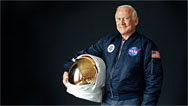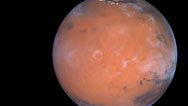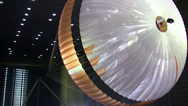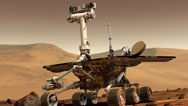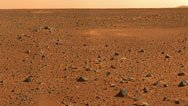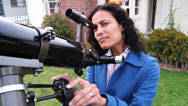
Is There Life on Mars?
The decades-long search for life on the Red Planet heats up with the discovery of frozen water. Airing August 10, 2011 at 9 pm on PBS Aired August 10, 2011 on PBS
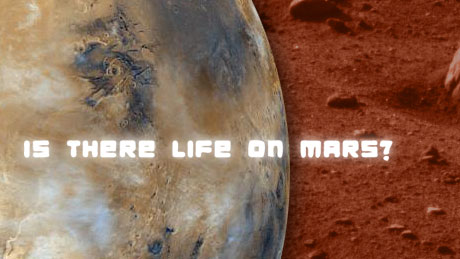
Program Description
Transcript
Is There Life on Mars?
PBS Airdate: December 30, 2008
NARRATOR: Is there life beyond Earth? To find out, we might look no farther than the planet next door. Mars may be our best hope for resolving the ultimate mystery of creation.
STEVE GOREVAN (Honeybee Robotics): It is the one planet out there that is Earth-like enough that we can imagine that life might have taken hold on that world.
CHRIS MCKAY (NASA Ames Research Center): If we go to Mars, will we find that, yes, the same events that led to life on Earth, happened independently on this other planet?
PETER SMITH (University of Arizona): And if we find evidence on our very next planet, Mars, then you have to say that has to be so common across the Milky Way, across the universe, you know, that we are not alone.
NARRATOR: Mars has more in common with our world than any place we know of in the universe, but it's still a world away. Getting an astronaut there to search for life is beyond us. So, for now, we must resort to the next best thing, robots. Mars today is a busy place. Three satellites orbit it, three Landers ponder its surface. They're finding a wealth of clues.
STEVE SQUYRES (Cornell University): Holy smokes! I'm just blown away by this.
MICHAEL HECHT (Jet Propulsion Laboratory): When that first data comes down, the sense of astonishment is indescribable.
Oh wow!
JOHN COATES (University of California, Berkeley): We would never have thought of looking for organisms like this on Mars.
NARRATOR: But they're also discovering that, in its past, Mars had some dark secrets.
SAMUEL KOUNAVES (Tufts University): Life can survive, survive in pretty harsh conditions, but there are limits.
ANDY KNOLL (Harvard University): Around four billion years ago, there was a cataclysmic event.
DAN McCLEESE (Jet Propulsion Laboratory): And this was big. This thing went, wham, right into the planet.
NARRATOR: Four and a half billion years ago, two young planets emerged, both brimming with promise, but something went very wrong with Earth's twin. Is There Life on Mars?, up next on NOVA.
Major funding for NOVA is provided by the following:
One of the factors impacting energy prices is growing global demand. And one way to put downward pressure on prices is to make more supply available. ExxonMobil has invented a breakthrough technology that we've just begun using here in the U.S. to access cleaner-burning natural gas that's locked in very tight, hard rocks. We could produce enough gas from one U.S. source alone to heat 50 million homes for almost a decade.
And David H. Koch. And...
Discover new knowledge: HHMI.
And by the Corporation for Public Broadcasting, and by contributions to your PBS station from viewers like you. Thank you.
NARRATOR: Mars eludes us. Even as this planet surrenders its secrets, it remains stubbornly guarded about one, the question we have come in pursuit of, above all others.
CHRIS MCKAY: The geology is fascinating, the climate is interesting atmospheric science. There is any number of things that you can study about the planet, but, to me, what makes Mars special is its potential as an abode for life.
NARRATOR: If there's life on Mars, there could be life throughout the universe.
CHRIS MCKAY: If it happened twice, right here in our own solar system, then we would have, for the first time, a good answer to the question, "is the universe full of life?" The answer would be yes.
PETER SMITH: The Holy Grail of Mars exploration is finding some form of Martian biology, what's often called the "Second Genesis." Did life start on Earth and Mars? Did it evolve in a totally different way than Earth life did?
NARRATOR: Peter Smith has been involved with seven missions to Mars. Each has only driven home how difficult it is to get there.
MISSION CONTROL: This is the Mars Polar Lander Mission Control at the Jet Propulsion Center.
NARRATOR: 1999: The Mars Polar Lander is about to touch down on the surface. Smith and his team should get word any moment. They wait...
PETER SMITH: There's nothing worse than no signal.
NARRATOR: ...and wait, for a signal that never comes.
PETER SMITH: I was trying to hold out a little hope that maybe it landed and the communication link hadn't quite set up yet, but I had the worst sinking feeling.
Doesn't look too good over there.
NARRATOR: During its descent, the Polar Lander disappeared.
PETER SMITH: You felt like somebody very close to you in your life, someone you love very dearly, had died through some tragic accident.
NARRATOR: At the time, Smith was already preparing his next mission, another lander called Mars Surveyor. But after the failure of Polar Lander, NASA cancelled the mission.
PETER SMITH: It was just miserable...all fell apart. All my house of cards just collapsed.
NARRATOR: Smith didn't give up. His plan: to take the technology from those failed missions out of mothballs, and repurpose it for another Lander. Every precaution would be taken to make sure this one would make it.
He christens the new mission with a name apropos: Phoenix.
PETER SMITH: We are rising from the ashes and we're going back to Mars, and so, Phoenix it is.
Sending a mission to Mars is somewhat like hitting a golf ball across the solar system. We'll see if we got our hole in one.
NARRATOR: Nine months later, Smith is back on track to search for signs of life on Mars.
Mission Control at NASA's Jet Propulsion Laboratory: If Phoenix lands, it'll be thanks to the engineers here, today, who made it happen.
But no one knows better than Smith what could go wrong.
MISSION CONTROL: ...sixty meters. You're standing by for touchdown. Touchdown signal detected.
NARRATOR: Finally, Peter Smith has arrived on Mars.
PETER SMITH: By gosh, we are going and doing it. We have a great chance of making a new discovery on Mars. It's the thrill of my life.
NARRATOR: Now that Phoenix has landed, NASA is sharing supervision of the mission with scientists at the University of Arizona, where Smith is based.
Phoenix is in the far north of Mars. So it has just three months before the polar sun will begin to set for the long winter, and with it will go the Lander's power supply. Time is already running out.
This is the 39th time we've tried to reach Mars, and only the seventh time we've actually landed there. It is a quest years in the making.
The first to attempt it were the Soviets. During the 1960s they launched eight missions; they failed eight times.
It wasn't until the late '70s that we'd get our first close view of the Martian surface, with the two Viking Landers. Each bears a $60 million box, packed with three biology experiments that are, in their day, state of the art. They're designed to test the soil for the presence of organisms.
MISSION CONTROL: Touch down! We have touch down!
NARRATOR: Hopes are running high. But when the pictures come in, there are no signs of life on Mars. As the experiments proceed, the news gets bleaker.
PETER SMITH: ...that this was devoid of life, that Mars was just a barren desert, that it may have been interesting four billion years ago, but today it's lacking in those ingredients that would allow life to flourish.
NARRATOR: Those ingredients for life are common on Earth. Billions of years ago, life, as we know it, needed three things to begin: one is an energy source, like heat from the volcanic fury of the Earth below and the Sun's rays from above; two are organics, carbon-based molecules, not living things, but the building blocks of life; but the third is scarce in our solar system, the medium that helps the chemicals intermingle.
CHRIS MCKAY: The most important requirement for life is liquid water, and that's the defining requirement for life in terms of our solar system. There's plenty of energy, there's plenty of carbon, there's plenty of other elements on all the planets in our solar system. What's rare is liquid water.
NARRATOR: Not only did Viking find no life, but no water, either. Mars was pronounced a wasteland.
DAN McCLEESE: It was really a bummer. "Mars was dead," quote. That was kind of the outcome, in the newspapers. And so we had a hiatus of missions to Mars of 20 years.
NARRATOR: Mars slipped away from the limelight. Then, in 1996, NASA scientists unveil a Martian rock, a meteorite that had landed in Antarctica, which appears to hold the fossilized traces of microscopic life, or so they think.
It turns out, the formations they found could have been produced by volcanic activity. "Follow the microbe" has not gotten NASA far. Instead, another strategy replaces it.
ANDY KNOLL: Certainly life, as we understand it, requires water. So NASA's explorational mantra has been "follow the water." And that's a pretty reasonable first step.
NARRATOR: 2004: NASA is putting wheels on the ground, times two. The Mars rovers Spirit and Opportunity have landed and are ready to roam the planet. The hunt for signs of water, present or past, is on.
Opportunity is at a spot called Meridiani Planum, and right away, the first pictures it sends home are stunning. Previous missions had sent photos of sheer desolation. But now, not far from the Lander is bedrock, the first ever seen on Mars.
STEVE SQUYRES: Holy smokes! I'm sorry, I'm just, I'm just blown away by this.
NARRATOR: Bedrock is a record of ancient environments and a dream come true for mission leader Steve Squyres.
STEVE SQUYRES: This is the sweetest spot I've ever seen. That outcrop in the distance is just out of this world. I can't wait to get there.
Most of the rock on Mars is volcanic lava flow. This is something else. This is an unusual Martian rock, at least compared to what we've seen everywhere else. The fact that these rocks are layered says that one possible origin for these is that they were laid down in liquid water. We do not know what's going on here, but the beauty of it is we have preserved, in front of us, a record that will answer that. And we have on our rover a toolkit of gizmos that will tell us that answer.
NARRATOR: One gizmo is a camera on the end of the robotic arm. It finds a puzzle never before seen on Mars: tiny, smooth spheres, like so many blueberries. Could they be the product of water? The pellets probably formed in the cavities of wet soil, perhaps in a salty ocean floor. If the team can find certain salts in the rock, it will clinch the ancient presence of water.
The place to find those chemical clues isn't on the surface. They would have seeped underground.
If only the team could look there!
They can. The rovers come equipped with a drill, the Rock Abrasion Tool, or RAT, as shown in this NASA animation. But the man in charge of the RAT is worried.
STEVE GOREVAN: I thought that before landing we had roughly been able to approximate anything that Mars was going to throw at us. Of course, what I neglected to think about was a rock that would be spitting out blueberries.
What we're afraid of happening is that we're going to dislodge one of the spherules, and that it's going to be like a pinball machine between the RAT and the surface of the rock. And this could be something that causes us some problems.
NARRATOR: The pressure is on to pick a rock to test.
STEVE GOREVAN: That spot for RATting has to be chosen now. And I mean, literally, in the next...well, it should be chosen in the next, it should be chosen in the next hour.
SCIENTIST ONE: What is this rock?
STEVE GOREVAN: That's McKittrick.
NARRATOR: They've selected a spot that's blueberry-free, hopefully.
STEVE GOREVAN: This just...I can't stand this. It's like I wish it was over.
REG WILSON: That's good, contact switch is tripped.
LEO BISTER (Flight Director): Are you ready to give a formal "Go" for RAT sequence, Master?
REG WILSON: Yes, I think we are.
MATT WALLACE (Mission Manager): We're definitive.
REG WILSON: We're go to RAT.
LEO BISTER: Go to RAT. I like that. Okay, you are clear to command.
STEVE GOREVAN: On my mark: 3, 2, 1, mark.
TOM MYRICK (Honeybee Robotics): The RAT has been engaged.
STEVE GOREVAN: I don't care if we find chili under there. I mean, I don't care. I just want to make that thing work.
NARRATOR: The result:...
STEVE GOREVAN: Yes, you see that hole?
NARRATOR: ...direct from Mars, a cleanly RATted hole.
STEVE GOREVAN: It's the most important hole we've ever dug.
NARRATOR: Finally, they can check the rock's chemistry. A spectrometer, onboard, is able to read each chemical as a different wavelength, breaking them down like a prism does light.
The rock is as much as 40 percent sulfate salt, a mineral that's only produced by soil interacting with water. That clinches it. Water was once here.
STEVE SQUYRES: That's beautiful, man. It's so different from anything we've seen before. That's great!
There's an awful lot of sulfate salt in this rock, and that's very, very hard to explain away, other than water having been massively involved in creating this stuff.
If you tasted this thing, you'd taste the salt. It's a very, very salt-rich rock. It looks like what geologists call an evaporite deposit. Evaporites form when you have liquid water with lots of stuff dissolved in it, and the water evaporates away and it leaves stuff behind.
NARRATOR: That stuff includes the blueberries. They hardened long ago, when these rocks were saturated with water, and they remained after the softer, surrounding rock eroded away.
STEVE SQUYRES: So we think we're parked on what was once the shore of a salty sea on Mars. That's pretty cool.
NARRATOR: The rovers have proven—even if they're finding no water on Mars now—it once flowed here, probably over three and a half billion years ago. But that doesn't necessarily mean there were living things here. It would have taken more to generate life. Amid its shallow seas, could Mars have produced that energy it takes to stir up a primordial soup?
In search of clues, Spirit sets off on a journey of 1.4 miles and two months, to explore the rugged Columbia Hills. But the trek takes such a toll on the rover, it might not make it to its destination.
STEVE SQUYRES: This is one beat up vehicle. This thing has traveled for three kilometers; it's coated with dust, we've got a gimpy wheel. That front right wheel is hurting.
NARRATOR: Spirit is down to five wheels, and there's no one to change a tire on Mars. Its rovings may be over. The team troubleshoots with their duplicate model at J.P.L.
SCIENTIST TWO: ...if it's going backwards and it's not a lead wheel.
SCIENTIST THREE: It takes some, but it's not...it still has the pressure. Anytime you drive that wheel...
STEVE SQUYRES: We've got this dead weight hanging off the front of the rover, in contact with the ground. And so when we drive now we have to drive that vehicle differently. We have to drive it backwards. We always drive backwards, dragging the dead wheel as we go. And we drag the wheel, we go very slowly. It's kind of painful to watch.
NARRATOR: But the setback turns up a surprise.
STEVE SQUYRES: It, against all expectations, led to the most important discovery Spirit has made. As we drag that dead wheel through the soil, it digs this wonderful hundreds-of-meters-long trench in the dirt. And we looked at the soil in the trench, and it was as white as bright snow.
NARRATOR: The white patches revealed by the gimpy wheel is another telltale mineral, silica, the stuff of sand and glass. This soil is 90 percent silica. It would have taken a lot of heat to generate that concentration. Perhaps hot springs, like the ones on Earth, existed on Mars, over three and a half billion years ago.
STEVE SQUYRES: This is a place where there was hot water and maybe steam, and it would come out of the ground. And that provides, at least locally, an environmental niche that would be suitable for life.
NARRATOR: On our planet, in these crucibles of hydrothermal activity, the most ancient bacteria may have first emerged. Liquid water, energy. When Mars and Earth were young, they might have both had what it takes to create organisms.
Roughly three and a half billion years ago, life may have had everything going for it on Mars.
CHRIS MCKAY: There's a real distinct parallel between early Mars and early Earth. There's a real parallel there that strengthens the case for there being life...having been life on Mars.
NARRATOR: But Andy Knoll is skeptical.
ANDY KNOLL: Let's think about the requirements of life. Almost all of life on Earth exists within a fairly narrow band of environmental conditions.
NARRATOR: Not all water sustains life.
ANDY KNOLL: It's not enough just to say water was there. The real question is the properties of water.
NARRATOR: The way the rovers found water was by detecting salt. So how salty were those seas?
ANDY KNOLL: It turns out that Meridiani Planum was way saltier than anything that's known to sustain life.
NARRATOR: If water is too salty or acidic it can be deadly. Three and a half billion years ago, the waters of Meridiani, where Opportunity is, could have been up to a thousand times saltier than Earth's oceans.
STEVE SQUYRES: It was pretty nasty stuff. This was not nice pure water, by any stretch of the imagination. It was very acidic. It was acid, sulfuric acid, and it was very salty, it was a brine. So, it would've been a very challenging place for life.
NARRATOR: What made the waters of Mars turn to poison? A crucial clue is revealed when Opportunity ventures to its next destination. The walls of Victoria Crater offer the chance to study the geological record: the deeper, the older.
STEVE SQUYRES: Young rocks at the top, older rocks at the bottom, you're doing a trip through time on Mars, and the deeper you go, the further back you're going. And we use those craters to provide us with access to other rocks below the surface.
NARRATOR: The base of these cliffs could have formed thousands of years before the rocks at the top. Was Mars wet then?
Sure enough, Victoria's walls are lined with distinct bands. Like the Grand Canyon, they are classic sedimentary layers, the product of era after era of water. Opportunity discovers that, moving forward in time, the salt concentration steadily increases. That means the amount of water bearing that salt was dwindling.
ANDY KNOLL: At Victoria we have evidence for some water early, less water later, still less water since then. It was evaporating and the result was it got saltier and saltier and saltier and saltier.
NARRATOR: It appears Mars evaporated to death. But why? What could wring an entire planet dry? Earth is able to stay wet and warm because its water is held in the protection of a blanketing atmosphere.
The Martian atmosphere is, today, less than one percent as dense as ours, though it must have once been robust, since water did flow here. What happened to it? Chances are the Sun destroyed Mars' atmosphere, by relentlessly bombarding it with solar wind.
Earth's atmosphere is protected from the Sun by a powerful magnetic field that's generated by a spinning molten core, creating a dynamo.
DAN McCLEESE: We're lucky on Earth, we wouldn't be here otherwise. The magnetic field actually shields the atmosphere and us. What it does is it manages to keep that solar wind from blowing the atmosphere away.
NARRATOR: But then, Mars is a tenth the mass of Earth. It doesn't seem large enough to generate a strong magnetic field. In fact, does Mars even have a molten core to begin with?
NARRATOR: Answers are emerging from a new age of Martian exploration. Satellites dispatched by NASA and the European Space Agency have been circling Mars.
DAN McCLEESE: The orbiters, for me, are, kind of, the unsung heroes of Mars. The global perspective is the thing that really gives you the understanding of how the planet works.
NARRATOR: With topographic data, collected from the satellite Mars Odyssey, scientists were able to model the longest canyon in the solar system. It stretches the length of the continental U.S. and could fit the Los Angeles city basin within the width of its walls.
With satellites, they are reconstructing the volcanic history of Mars, the planet that produced the solar system's largest volcano. Olympus Mons spans an area the size of Arizona, and rises to three times the height of Everest.
Volcanoes are no longer active on Mars, but their presence means that, at one time, the planet did have a molten core. Still, how could such a small planet pump up enough juice to power a magnetic field?
Some scientists believe that Mars got a little help from a visitor from space, a giant asteroid. Four billion years ago, the solar system was a violent place.
ANDY KNOLL: There was an influx of meteors. And, in fact, there are craters on Mars into which you could fit Australia.
NARRATOR: The theory is one object got caught in Mars' orbit.
SUE SMREKAR (Jet Propulsion Laboratory): There could've been a body that was circling Mars and circling Mars. And it's possible that asteroid circling Mars created so much heat and so much deformation inside that it actually started the dynamo.
NARRATOR: With sheer tidal force, the asteroid may have churned the planet's molten core, powering up its magnetic field and its atmosphere in turn, at least for a time. What, then, went wrong?
DAN McCLEESE: So, on Mars, we ask the question, "Well, where is the magnetic field?"
NARRATOR: Earth's magnetic field is one powerful cloak. But that's not what the orbiters find on Mars.
DAN McCLEESE: With the Mars Global Surveyor, we put a magnetometer, a very, very sensitive experiment, onboard. We put it into close orbit, and, lo and behold, it found the trace of an ancient magnetic field on the planet.
NARRATOR: Unlike Earth, Mars, today, has countless small magnetic fields pock-marking its surface. Like shrapnel left at a bombsite, they seem like the aftermath of some violent event, one that may have also left another clue at the scene: Mars is misshapen.
SUE SMREKAR: We could see that the southern highlands were much more heavily cratered and much higher. The north is much lower, much smoother.
NARRATOR: Mars has a clear division cutting straight through it. The north is much less weathered than the south. The reason? The leading theory is Mars suffered a massive collision. Perhaps that asteroid drew too close.
DAN McCLEESE: And this was big. And the idea is that this thing went, wham, right into the planet, pushed the atmosphere away from the planet, just, literally, blew the atmosphere away. The object may have changed, forever, the south and the north, making the two very, very different. And it may have been the way, finally, that the dynamo changed the way in which it was operating. And so the magnetic field went away.
NARRATOR: In one staggering blow, Mars may have lost the driving force behind its molten core and its magnetic field. Stripped of its protective cloak, the planet was forever left exposed to a searing assault of solar wind, preventing its atmosphere from reforming.
In the areas where the rovers have been traveling, it appears that over three billion years ago, Mars was transformed from a warm, wet place, possibly brimming with early life, to an arid, acidic corpse. But is it certain that any and all life on the planet was wiped out?
ANDY KNOLL: There's part of me, I must admit, that would root for the idea of Martian life. Is it impossible that life exists on Mars? No, but I think it's not the odds on bet.
CHRIS MCKAY: I would take Andy up on his bet. I think the chance of finding life on Mars is high, or I wouldn't be spending my time and energy searching for it.
NARRATOR: Chris McKay holds out hope that some organisms may have held on, adapting to a harsher world. Now, to find out if there could be life on Mars, he's headed for the ends of the Earth.
CHRIS MCKAY: We're on our way up to far north of the Arctic. The polar regions are a prime target for searching for evidence of life.
NARRATOR: It's summer at Axel Heiberg, but, come winter, this island can get down to 40 below.
McKay has come to study a remarkable feature. Here flow two springs that are up to 10 times saltier than seawater. Salt, at this concentration, is usually poisonous. Could microbes survive these waters? McKay has reason to think so.
CHRIS MCKAY: On Earth, searching for life is easy. No matter where you look, just about, you find evidence of life.
NARRATOR: To what lengths will life go? It faces challenges world over. In the driest, hottest desert, microbes thrive; in the oceans' sunless depths, as well; even in the bowels of the Earth, in caves seething with toxic fumes and scalding acid, at almost every limit, life prevails.
Salty as the springs of Axel Heiberg are, they harbor miniature ecosystems.
CHRIS MCKAY: We find a dark, rich soil, right above the ice, full of all sorts of bacteria. It looks kind of like the soil you find in a, in a forest floor. It's that rich.
NARRATOR: So, if life is this resilient on Earth, how about on Mars? Could it have survived on a planet stripped of its atmosphere? Somehow, somewhere, could it have adapted to harsher conditions and found refuge?
Maybe we've just been looking in all the wrong places. The sites the rovers explored were both along the Martian equator. But there's more to a planet than just two spots.
SUE SMREKAR: Imagine if you just went to Death Valley or you just landed on the Arctic tundra, you know, you would get incredibly different view of the Earth.
CHRIS MCKAY: Sure, where the rovers landed could have been an acid wash, very salty, not very friendly to life. But I bet if we landed in another place, we might find something different.
NARRATOR: It would have to be a place that somehow retained those same life-friendly ingredients: liquid water—not too salty or acidic—an energy source, and nurturing organic molecules.
"Following the water" calls for at least one more stop, and this time, NASA is aiming for a spot on Mars where water may still exist. We've long known the Martian ice caps in the north and south are made of carbon dioxide, dry ice, but some held out hopes water lies beneath it. In 2002, the satellite Odyssey was able to peer below the surface, to tell which elements are present.
PETER SMITH: Odyssey actually discovered hydrogen in the upper three feet of soil.
NARRATOR: A vast reservoir of hydrogen, marked blue here. Could that H be a sign of H2O? If there's still water on Mars, this is where to look for it.
NARRATOR: It's time for the Phoenix Lander to take up the hunt, under the leadership of Peter Smith.
PETER SMITH: The polar north on Mars, potentially, was once liquid water. We don't know that for a fact; we're going there to find out.
NARRATOR: Tucson, Arizona, is now Mars Central.
PETER SMITH: This is the latest image. This is where it came down.
NARRATOR: Unlike the rovers, this robot is not just looking for signs of a watery past. It's taking the search for life one step closer. Its goal?
PAT WOIDA (University of Arizona): To look for water and to assess habitability. That is, in the past, was the planet able to support life, and did it?
NARRATOR: Phoenix will focus on one area and dig. It's not designed to detect life itself, but it can tell if conditions here were once right for it.
The first "sol," or Martian day, and already it looks like the team has landed in the right place.
PETER SMITH: This is the most ice-rich area outside of the polar cap.
NARRATOR: The Lander uses a camera on its arm to peer under itself. It discovered that the descent thrusters had, by chance, cleared a patch of soil away, revealing what might be ice.
PETER SMITH: This is an interesting place we landed. If you came with a broom, you could sweep off that...it's only two inches of soil over ice. You could actually sweep off all that soil, off into a corner, and you would have, almost, a skating rink with some interesting bumps on it.
SCIENTIST FOUR: Hey, Matt, did you see the color picture of what you dug up?
MATT/SCIENTIST FIVE: No, no, I haven't.
SCIENTIST FOUR: ...unidentified white stuff in there?
SCIENTIST SIX: It was the white stuff that...
MATT/SCIENTIST FIVE: Oh, wow!
NARRATOR: But whether it's carbon dioxide ice or water ice or something else is the question.
MATT/SCIENTIST FIVE: That white stuff...
SCIENTIST FOUR: Well, yeah.
MATT/SCIENTIST FIVE: Wow.
PETER SMITH: This material we think is ice.
We found some bluish ice-like material that has the science team arguing incessantly about whether it's ice or salt or some other exotic material.
CAROL/ SCIENTIST SEVEN: That's not permafrost, that is ice.
NARRATOR: That bluish, ice-like material turns up as nuggets in a ditch Phoenix dug. The team intentionally leaves the area undisturbed and watches.
MARK LEMMON (Texas A&M University): These two...we were trying to put the pictures up on the screens as fast as we could, compare them to the pictures that we'd taken a few days before. And it just took seconds of looking at the picture to say, "Yes, stuff has changed."
NARRATOR: Lo and behold, the clumps disappear.
MICHAEL HECHT: Oh, is that pretty.
NARRATOR: The reason? They've vaporized. That wouldn't happen to carbon dioxide ice, not at 26 below zero.
MARK LEMMON: Only water is going to actually sublimate away at those temperatures. We watched it just "poof," go away, over the course of a couple days.
NARRATOR: For the first time, we have touched water on another planet. And yet, how does that help the chances for life on Mars? Microbes need liquid water. Is the Martian north hiding that somewhere?
CHRIS MCKAY: Phoenix is the first Mars mission ever to actually come in contact with real H2O. It's ice, but there it is: water, frozen solid. And the question then is, "Was it ever liquid?"
NARRATOR: Phoenix can find out. The robotic lab has an instrument onboard that can detect if the soil here has come in contact with liquid water. It's called TEGA, and it can distinguish different chemicals by heating them in a small oven. Each boils off at a different temperature.
SCIENTIST EIGHT: Let's do the... another tool-frame rotation of negative .1.
SCIENTIST NINE: Minus .1 tool-frame.
NARRATOR: Working with an exact model of Phoenix, the team's been running simulations, in Arizona, with dirt that's dry and granular, characteristics they expect Mars dirt to have. All they need now is to get Phoenix a scoop of the real thing so TEGA can run its test.
SCIENTIST TEN: The right stuff's lit; it's the stuff on the screen.
NARRATOR: Sample after sample is delivered, but the dirt won't sprinkle down through the screen to the TEGA oven below.
SCIENTIST ELEVEN: There's the full ten-minute shake right there.
SCIENTIST TWELVE: Okay, so the bottom line is we didn't get any dirt.
NARRATOR: Martian soil is surprisingly sticky.
PETER SMITH: Well, the TEGA instrument has not been a stellar performer, unfortunately. It's had a lot of little problems. Now, are these just growth pains or learning difficulties, or is it really an instrument on the way out? This has been an, a very emotional ride.
NARRATOR: The best minds in space science are devoted to one thing: getting dirt past a screen. So far, the dirt is winning. Finally...
RAY/SCIENTIST THIRTEEN: The TEGA oven is full.
SUZANNE YOUNG (Tufts University): Really?
PETER SMITH: Long time coming, but boy it's sweet when it's here, right?
HEATHER/ SCIENTIST FOURTEEN: Okay, can we be happy now?
PETER SMITH: We can be happy now.
NARRATOR: Soon, there's more reason to be happy. TEGA's ovens turn up carbonates, chalk-like minerals that form in the presence of liquid H2O. Water, liquid water, was at this spot on Mars. But how could that be? Temperatures recorded in the Martian polar north have never gotten warmer than 13 below zero. How could the ice here have ever melted?
Another satellite, the Mars Reconnaissance Orbiter, found a clue. Probing the polar cap by bouncing radio waves down, like sonar, it discovered distinct layers of dust and ice, laid down through a succession of climates, colder and warmer.
DAN McCLEESE: How do you get layers on planets? Well, you get cycles of hot and cold over the surface of the planet.
NARRATOR: And what makes the temperature change so much? That happens over phases that last millions of years, as the globe tilts more or less toward the Sun.
NARRATOR: A planet spins like a top. The Earth has a large moon that helps to stabilize it, so it rotates relatively steadily. But the two moons Mars has are both small, so it's more prone to wobbling.
Over the course of millions of years, it can tilt a lot. Five million years ago, the Martian North Pole was angled at 45 degrees.
CHRIS MCKAY: So the amount of sunlight that it receives in a day would be twice what it's receiving now. So, imagine, 5,000,000 years ago, it could have been as warm as the polar regions on Earth.
NARRATOR: This part of Mars may have been warmer as recently as 5,000,000 years ago—long after the planet's atmosphere got ruined—warm enough to be wet. Did that make the north life-friendly? Not if conditions here were extremely acidic or salty, like where the rovers landed.
To find out how life-friendly this area was, Phoenix will use a second lab, called MECA. It will test its sample's properties not by heating it up, but by adding water it's brought along.
MICHAEL HECHT: It stirs it up to determine what comes out of the soil. What kind of tea does this Martian soil make?
NARRATOR: Step one is getting a sample into a cell. After TEGA's troubles, no one is taking that for granted.
SCIENTIST FOURTEEN: ...anything changing down here at all.
NARRATOR: Looking at the visuals from Mars, it's hard to tell if the soil actually got delivered. The team can only hold out hopes their experiment is underway.
SUZANNE YOUNG: Just waiting, that part was agony. Every second was an hour. It was definitely the longest hour of my life.
NARRATOR: Then...
MICHAEL HECHT: When that first data comes down from Mars, and you suddenly see these wiggles on the screen, just like you've seen in the laboratory, the sense of astonishment is indescribable, just seeing it. We know for the first time the pH of Mars.
NARRATOR: The pH, the level of how acidic the soil is.
MICHAEL HECHT: I want a number from one...zero to 12, something that people have been speculating about for years and years and years. Give us a number from zero to 12.
NARRATOR: There's a surprise.
MICHAEL HECHT: It's basic. It's basic?
NARRATOR: It's not acidic—a reading of 8.3, the kind of soil asparagus could grow in—so far, so good for life.
SUZANNE YOUNG: Really? Mars?
NARRATOR: Next, what's that salt content in the sample?
MICHAEL HECHT: Beautiful. Oh, that is gorgeous.
NARRATOR: It's unexpectedly low, another plus for life.
MICHAEL HECHT: Yeah, that's as pretty as we got there.
CHRIS MCKAY: At the Phoenix site we find relatively pure ice; we find neutral conditions; we find low...salts, but at low levels.
SAMUEL KOUNAVES: For a lot of us, it's a new view of Mars. It's obviously not super salty; it's obviously not super acidic or super basic. Bacteria might enjoy this stuff. So some organisms might be able to survive, if the other part of the environment was good.
NARRATOR: But that's a big "if." Just when all readings are pointing to a life-friendly environment, one comes up that's baffling.
MICHAEL HECHT: After the initial analysis, that's where things started getting truly interesting.
NARRATOR: There's an unexpected chemical called perchlorate.
MICHAEL HECHT: It was about the farthest thing from our imagination that we might find there.
NARRATOR: On our planet, perchlorate is a toxic chemical, manufactured for rocket fuel and fireworks. It's rare in the natural world, except in the most forbidding deserts on Earth.
MICHAEL HECHT: This stuff, liquid perchlorate, is not, is not a material that microbes can very easily live in. It's not a very friendly environment.
SAMUEL KOUNAVES: Life can survive in pretty harsh conditions, but there are limits.
NARRATOR: What are the chances of life amid perchlorate? It's a new question for Mars scientists, not for John Coates.
JOHN COATES: People have said that the presence of perchlorate on Mars is indicative that life couldn't be present, that this compound is too toxic. But that statement is not true.
NARRATOR: At a lab in Berkeley, California, Coates and his team have been quietly studying a group of microbes that is about to attract some attention.
These are his subjects, organisms that thrive on perchlorate, consuming it as we do the air we breathe, a trait that could come in handy on oxygen-deprived Mars.
The Martians we've long sought may be like these bacteria, called dechloromonas.
JOHN COATES: We would never have thought of looking for organisms like this on Mars. Now that we know that this compound is present on Mars it certainly opens up that as a life form that could potentially have existed on Mars.
NARRATOR: Could dechloromonas or its alien counterparts have ever stood a chance on Mars? Phoenix will never know. Its experiments done, the team disperses. As the Martian polar night descends, the Lander's solar power dwindles. Phoenix will soon be entombed in dry ice, never to awaken.
The search for signs of Martian life will fall to the next mission.
The Mars Science Lab, M.S.L., will be the size of a small car. It will be bristling with technology, an array of imagers, sampling tools and labs that will make its predecessors seem quaint.
CHRIS MCKAY: I'm very excited about M.S.L. In an interesting way, it's a compliment to the Phoenix mission. To me, we've already followed the water. We know there's water on Mars; "check," on the water. The next thing we need to do in terms of a strategy for life search is follow the organics, find organics.
NARRATOR: We have come a long way in meeting our neighbor next door. We've gone from envisioning it as barren and moon-like to a place as diverse as it is familiar, a world that could well have harbored life.
We can now imagine the day, billions of years past, when two planets took their turn round the sun, neck and neck in the race to claim life's course.
We know what happened on Earth, but the other was dealt a blow. If there's proof, on Mars, of a life-filled past, it is still waiting to be discovered.
On NOVA's Is There Life on Mars? Web site, check out our Q&A with a NASA astrophycisist, explore interactives and slide shows, or watch any part of this program again. Find it on PBS.org.
Broadcast Credits
Is There Life on Mars?
PBS Airdate: December 30, 2008
- Written and Produced by
- Jonathan Grupper
- Co-Producer
- Anna Lee Strachan
- Senior Producer
- Julia Cort
- Edited By
- Sak Costanzo
- Additional Producing
- Mark Davis
- Narrated By
- Jay O. Sanders
- Camera
- Nathan Shelton
Keith Page
Gary Henoch
Michael Anderson
Reuben Aaronson
Peter Bonilla
Tim Gibbons
Brad White - Sound Recordists
- Jake Sutton
Mike Andrews
Andy Wiskes
Nathan Shelton
Jim Scott
Michael Cottrell - Assistant Camera
- Dan Merrill
- Grip
- Josh Roberts
- Music
- Gary Pozner
Rob Morsberger
Tom Phillips
Andreas Bjí¸rck - Animation
- Nth Degree Design & Visual fx, Inc
Anthony Kraus - Assistant Editors
- Evelyn Carrigan
Demi Ray
Chris Chandler
Tyler H. Walk - Online Editor and Colorist
- Michael H. Amundson
- Audio Mix
- John Jenkins
- Production Assistants
- Andrew Clark
Naava Grupper
Lou Wiskes
Keith Woodhams - Interns
- Maya Peeva
Rose Rongitsch
Alex Marinello - Archival Material
- NASA
Jet Propulsion Laboratory
Goddard Space Flight Center
Scientific Visualization Studio
California Institute of Technology
University of Arizona
Texas A&M University
Lockheed Martin
Indiana State Museum
ITN
ESA - Rover and Spacecraft Animation
- Maas Digital, LLC
Dan Maas
John Niehaus
Justin Wick - Mars Animation and Graphics
- Anna D. Saraceno, MDTV Productions
- Early Mars Flyover Visualizations
- Kees Veenenbos
- Special Thanks
- Sara Hammond
John Beck
Zena Cardman
JPL Media Relations
Harvard Museum of Natural History - NOVA Series Graphics
- yU + co.
- NOVA Theme Music
- Walter Werzowa
John Luker
Musikvergnuegen, Inc. - Additional NOVA Theme Music
- Ray Loring
Rob Morsberger - Closed Captioning
- The Caption Center
- Publicity
- Carole McFall
Eileen Campion
Victoria Louie
Karinna Sjo-Gaber
Karen Laverty - Marketing
- Steve Sears
- Researcher
- Kate Becker
- Senior Researcher
- Gaia Remerowski
- Production Coordinator
- Linda Callahan
- Paralegal
- Sarah Erlandson
- Talent Relations
- Scott Kardel, Esq.
Janice Flood - Legal Counsel
- Susan Rosen
- Production Assistant
- Ryan Murdock
- Post Production Assistant
- Darcy Forlenza
- Associate Producer, Post Production
- Patrick Carey
- Post Production Supervisor
- Regina O'Toole
- Post Production Editors
- Rebecca Nieto
Jason York - Post Production Manager
- Nathan Gunner
- Compliance Manager
- Linzy Emery
- Development Producer
- Pamela Rosenstein
- Supervising Producer
- Stephen Sweigart
- Business Manager
- Joseph P. Tracy
- Senior Producer and Project Director
- Lisa Mirowitz
- Coordinating Producer
- Laurie Cahalane
- Senior Science Editor
- Evan Hadingham
- Senior Series Producer
- Melanie Wallace
- Managing Director
- Alan Ritsko
- Senior Executive Producer
- Paula S. Apsell
Image Composite
- (Mars)
- © NASA/JPL (martian soil) © NASA/JPL-Caltech/University of Arizona/Texas A&M University
Participants
- John Coates
- University of California, Berkeley pmb.berkeley.edu/~coates/people/johncoates.htm
- Steve Gorevan
- Honeybee Robotics www.honeybeerobotics.com/
- Mike Hecht
- Jet Propulsion Laboratory phoenix.lpl.arizona.edu/hechtMichael.php
- Andy Knoll
- Harvard University
- Mark Lemmon
- Texas A&M University
- Dan McCleese
- Jet Propulsion Laboratory www.jpl.nasa.gov/bios/mccleese/
- Chris Mckay
- NASA
- Peter Smith
- University of Arizona phoenix.lpl.arizona.edu/smithPeter.php
- Sue Smrekar
- Jet Propulsion Laboratory www.nasa.gov/mission_pages/MRO/launch/bio-smrekar.html
- Steve Squyres
- Cornell University
- Pat Woida
- University of Arizona
- Suzanne Young
- Tufts University
Sources
Links
HiRISE—High Resolution Imaging Science Experiment
hirise.lpl.arizona.edu/index.php
Launched in 2005, HiRISE is flying aboard the Mars Reconnaissance Orbiter spacecraft. On this site from the University of Arizona, explore hundreds of stunning, close-up HiRISE images of the martian surface, including many in 3-D (you'll need goggles).
Name the Rover
marsrovername.jpl.nasa.gov/
Take a shot at naming NASA's next Mars rover at this website from the Jet Propulsion Laboratory.
From Earth to Mars—An Interactive Timeline
phoenix.lpl.arizona.edu/timeline.php
Track the history of Mars explorations through this detailed interactive chronology from NASA.
Mars 360—Views of the Red Planet
www.jpl.nasa.gov/multimedia/slideshows/mars-200701/index.cfm
This NASA slide show captures some of the characteristic images of Mars, from the microscopic findings of Spirit to the color-enhanced expanses captured by the Mars Reconnaissance Orbiter.
Phoenix Mars Mission
phoenix.lpl.arizona.edu/
The Phoenix may have shut down, but scientists are still at work analyzing the data obtained during the groundbreaking mission. Find the latest updates at the mission homepage.
Mars Exploration Rover Mission
marsrovers.jpl.nasa.gov/home/index.html
See the latest images and data from the martian rovers, an overview of mission goals, background information about Mars, and updates on Spirit and Opportunity on this NASA website.
Viking Mission to Mars
nssdc.gsfc.nasa.gov/planetary/viking.html
A look back at NASA's historic and successful Viking missions launched in the 1970s. The images sent back to Earth remain the most complete view of Mars to date and contain the first evidence that surface water may have once existed on the Red Planet.
Books
A Passion for Mars: Intrepid Explorers of the Red Planet
by Andrew Chaikin. Abrams, 2008.
Mars 3-D: A Rover's-Eye View of the Red Planet
by Jim Bell. Sterling, 2008.
How to Live on Mars: A Trusty Guidebook to Surviving and Thriving on the Red Planet
by Robert Zubrin. Three Rivers Press, 2008.
A Traveler's Guide to Mars: The Mysterious Landscapes of the Red Planet
by William K. Hartmann. Workman, 2003.
Mapping Mars: Science, Imagination, and the Birth of a World
by Oliver Morton. Picador, 2002.
Life's Matrix: A Biography of Water
by Philip Ball. Farrar, Strauss and Giroux, 2000.
Articles
"Phoenix Lander Searches for Martian Microbial Oases"
by Alexis Madrigal. Wired, September 5, 2008.
blog.wired.com/wiredscience/2008/09/mars-phoenix-fi.html
"White Patches Found in Mars Trench Are Ice, Scientists Say"
by Kenneth Chang. The New York Times, June 20, 2008.
www.nytimes.com/2008/06/20/science/space/20mars.html?partner=rssnyt&emc=rss
"Probe Breaks the Ice on Mars, Literally"
by Dan Cray. Time, May 26, 2008.
www.time.com/time/health/article/0,8599,1809476,00.html
"Making Tracks on Mars"
by David Grinspoon. Scientific American, October, 2005.
www.sciam.com/article.cfm?id=making-tracks-on-mars
"Visiting Mars? Don't Drink the Water"
by Mary Carmichael. Newsweek, March 15, 2004.
www.newsweek.com/id/53375
Preview
Full Program | 51:57
Full program available for streaming through
Watch Online
Full program available
Soon




